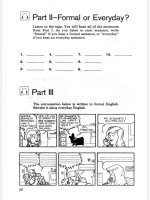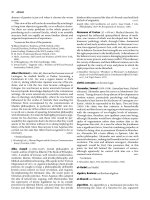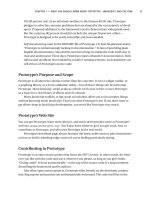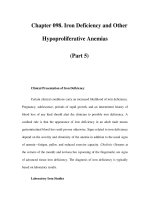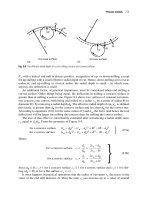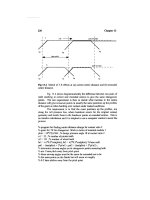Soil and Environmental Science DICTIONARY - Part 5 pps
Bạn đang xem bản rút gọn của tài liệu. Xem và tải ngay bản đầy đủ của tài liệu tại đây (105.22 KB, 1 trang )
559
References:
Sources of Illustrations
Figures for: Relationship among osmotic, matric, and combined soil water potential; Volume of solids, water,
and air in a loam soil at saturation, Þeld capacity, and wilting point. Adapted from Brady, N.C. and
Weil, R.R. 1996.
The Nature and Properties of Soils.
Prentice-Hall, Upper Saddle River, New Jersey.
Figure for: Stable carbon isotope ratios. Adapted from Boutton, T.W. 1991. Stable Carbon Isotope Ratios of
Natural Materials: II. Atmospheric, Terrestrial, Marine, and Freshwater Environments. In D.C.
Coleman and B. Fry (Eds.),
Carbon Isotope Techniques
. Academic Press, New York.
Figure for: The rhizosphere. Adapted from Bolton, H. and Frederickson, J.K. 1993. In Metting, F.B. (Ed.)
Soil Microbial Ecology: Applications in Agricultural and Environmental Management.
Marcel Dekker,
New York.
Figure for: Typical growth phases of a bacterial population. Adapted from Brock, T.D., Smith, D.W., and
Madigan, M.T. 1984.
Biology of Microorganisms.
Prentice-Hall, Englewood Cliffs, NJ.
Figures for: Cambium; Illuviation; Mass movement of rock, soil and organic matter initiated by creep, fall, ßow,
slide, and slump; Parts of a root; Perched water table; Types of folds. Adapted from Dunster, J. and
Dunster, K. 1996.
Dictionary of Natural Resource Management.
CAB International, Wallingford, U.K.
Figure for: Terrestrial Ecozones of Canada (Appendix E). Adapted from Ecological StratiÞcation Working
Group. 1996.
A National Ecological Framework for Canada.
Agriculture and Agri-Food Canada,
Research Branch, Centre for Land and Biological Resources Research and Environment Canada, State
of Environment Directorate, Ottawa.
Figure for: The greenhouse effect. Adapted from Janzen, H.H., Desjardins, R.L., Asselin, J.M.R. and Grace,
B. (Eds.) 1998.
The Health of Our Air: Toward Sustainable Agriculture in Canada.
Research Branch,
Agriculture and Agri-Food Canada, Ottawa.
Figures for: A soil bacterium; Conidia; Hypha; Mycelium; Representatives of the soil protozoa. Adapted from
Killham, K. 1994.
Soil Ecology.
Cambridge University Press. Cambridge, U.K.
Figures for: Nutrient diffusion; Root interception. Adapted from Ontario Ministry of Agriculture, Food and
Rural Affairs. 1998.
Soil Fertility Handbook. Publication 611.
Queen’s Printer for Ontario. Toronto.
Figure for: Association of arbuscular mycorrhizal fungi and soil aggregate of a plant root. Adapted from Paul,
E.A. and Clark, F.E. 1996.
Soil Microbiology and Biochemistry
. 2nd ed. Academic Press. London.
Figures for: Different degrees of soil development found in a catena; Shoulder, backslope, and footslope
landform elements; Flowlines in areas of proÞle plan curvature; Basic slope morphological units.
Pennock, D.J. 2001. Personal communication. University of Saskatchewan. Saskatoon, Saskatchewan.
Figure for: The global carbon cycle. Adapted from Schmiel, D. 1995. Terrestrial ecosystems and the carbon
cycle.
Global Change Biol.
1:77-91.
Figures for: Soil texture classes; Types, kinds, and classes of soil structure (both in Appendix B). Reproduced
with permission from Soil ClassiÞcation Working Group. 1998.
The Canadian System of Soil Clas-
siÞcation.
3rd ed. NRC Research Press, Ottawa, Canada.
Figure for: The nitrogen cycle in soil. Adapted from Stevenson, F.J. (Ed.) 1982.
Nitrogen in Agricultural Soils
.
Number 22.
American Society of Agronomy. Madison, Wisconsin.
Figures for: Buried soil; Solum. VandenBygaart, A.J. 2001. Personal communication. Department of Land
Resource Science, University of Guelph, Guelph, Ontario.
3115_book Page 559 Tuesday, August 12, 2003 11:25 AM
© 2001 by CRC Press LLC
